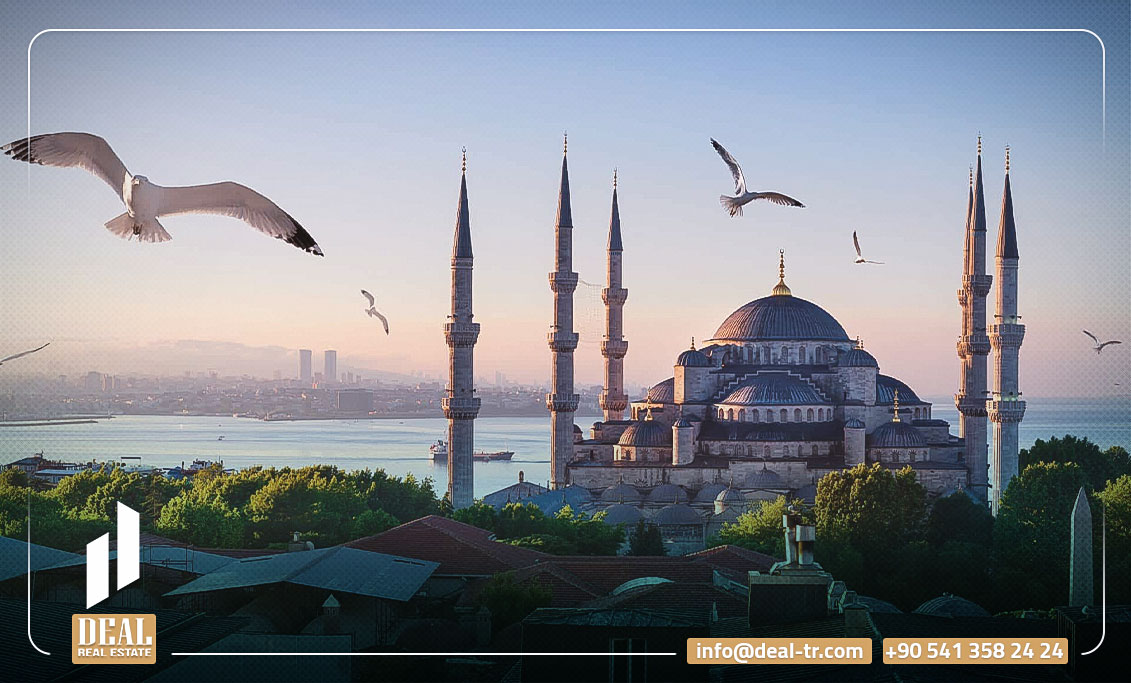Learn about the most famous mosques in Istanbul
Learn about the 16 most famous mosques in Istanbul

The city of minarets, or the city of Istanbul, where Istanbul is one of the cities that contain the most significant number of mosques in the world.
The most famous and beautiful mosques in Istanbul:
Hagia Sophia Mosque - Ayasofya Müzesi
The Hagia Sophia Mosque is one of the most famous tourist attractions in European Istanbul, and it is distinguished by its ancient history that extends back to the year 537 AD, the year in which the Roman Emperor Justinian built it.
The Hagia Sophia Mosque was a church at its inception, but after the Ottoman conquest of Istanbul, it was converted into a mosque by Sultan Mehmed, the Conqueror. Finally, in the era of transforming the country into a republican system, the mosque was converted into a religious museum that includes an extensive collection of huge pictures.
The Hagia Sophia Mosque is a unique artistic and architectural tower, as it is located in the Sultan Ahmed area near the Sultan Ahmed Mosque. It is one of the most prominent examples of Byzantine architecture and Ottoman decoration.
Eyup Sultan Camii Mosque
Sultan Ayoub Mosque is an old Ottoman mosque near the Golden Horn in the Ayoub region in the European part of Istanbul. It is the first mosque to be built after the conquest of Constantinople in the year 1458, and the current building dates back to the beginning of the nineteenth century.
The mosque complex outside includes a separate building, the tomb of the great companion Abu Ayyub al-Ansari (may God be pleased with him) for those who want to visit him, and many other graves outside the complex. Moreover, there are some of the belongings of the Prophet Muhammad; may God bless him and grant him peace in that shrine outside the mosque.
A mosque as if I ate in Turkey Sanki Yedim Camii
As if I ate at one of the famous mosques in Istanbul. It is a small mosque located in the Fatih district of Istanbul. The mosque's construction dates back to the eighteenth century during the Ottoman Empire. It gained great fame from its strange name until it became a tourist destination.
As for the story of the mosque, it is: that a person was living in the Al-Fateh region named "mosque'sKhair al-Din Kaji Effendi," and when he was walking in the market, and his soul was longing to buy fruit, meat, or sweets, he would say to himself: "Sunky Yadam," that is, in the sense of "as if I I ate." Then he keeps the price of that food in a box for him.
After several years of saving most of his income, the money in his fund increased a little until he could build a small mosque in his locality with the money he had saved. When the people of the locality knew his story, they called the mosque the name (Sanki Yadam Mosque), which means "as if I ate."
New Eminonu Mosque Yeni Cami
The new Eminonu Mosque has a privileged location in the heart of Istanbul in the Eminonu region. It has a charming view of Golden Horn Bay and is close to the Egyptian market. This mosque was built by order of the wife of the Ottoman Sultan Murad III in the early seventeenth century.
The new Eminonu Mosque has inaugurated in 1665 AD; after its construction, it took a period of more than half a century to become one of the most important monuments of the city of Istanbul.
Sinjaqlar Mosque "Hira Cave Mosque" in Istanbul Snjaqlar
Sangkılar Mosque is one of the most famous mosques in Istanbul. It is located in Büyükçekmece in a large area of 700 meters. This mosque is characterized by a unique architectural style that is different from other mosques, as the underground building of the mosque, and the simplicity of the interior design, provide worshipers with a quiet atmosphere and are far from The chaos of everyday life.
The Sangkılar Mosque was built by the Turkish designer Emre Arolat, inspired by the idea of building it from the Cave of Hira, and being an excellent example of modern architecture; it won first place in the International Architecture Festival for Religious Places competition.
Arab Mosque in Istanbul Arap Camii
The Arab Mosque is considered the first mosque built by the army of Arab Muslims, led by Maslama bin Abd al-Malik in the year 717 AD, and it joins the vast number of Istanbul mosques, which is located in the Galata neighborhood, in the Beyoglu district, in the center of Istanbul.
The Arab Mosque is characterized by the shape of the converted minaret from the church bell tower, which contains 102 steps and is distinguished by a distinctive architectural character, characterized by the Andalusian urban style, as it is one of the strangest mosque structures in Istanbul.
Sultan Ahmed Mosque in Istanbul Sultan Ahmet Camii
The Sultan Ahmed Mosque, or as it is known as the Blue Mosque, is one of the most prominent historical mosques in Istanbul. It is located in Sultan Ahmed Square, opposite the Hagia Sophia Mosque. Built by Sultan Ahmed I between 1609-1616 AD, the mosque is famous for its distinctive architecture, as it is one of the most important and largest mosques in the Islamic world.
The Sultan Ahmed Mosque is characterized by its features of architecture, which date back to the Byzantine and Ottoman eras, and it has a miraculous view of the Sea of Marmara. As for the characteristics of this mosque, it has an expansive courtyard, a height of 43 meters, and more than 200 windows. In addition, its interior walls are decorated with patterned blue Iznik tiles.
Ortaköy Camii Mosque in Istanbul
The Ortakoy Mosque is directly located in the Ortakoy area overlooking the Bosphorus Strait, which gives the mosque an infinite description of beauty. The mosque was built by Sultan Abd al-Majid in the year 1853 AD, with solid foundations and pillars, with a depth of 20 meters, to increase the durability of the building and protect it from earthquakes.
The architect, Qarhabet Amir Balian, built the mosque in the style of Baroque architecture. It consists of two main pillars, namely, the worship corner and another corner for the Sultan's forum, and the presence of a dome with beautiful ornaments characterizes it.
Fatih Camii Mosque
Al-Fateh Mosque is one of Istanbul's largest and most magnificent mosques and attracts tourists worldwide. Before it was transformed into a mosque by order of the Ottoman Sultan Mehmed Al-Fatih in 1470, it was a church in the Byzantine era. Therefore, the Al-Fateh Mosque is characterized by historical and tourist importance, making it one of the most important religious places. The mosque has two identical minarets and a large courtyard surrounded by many columns and columns arches.
In its southern part is the shrine of Sultan Muhammad al-Fatih, which is surrounded by a decorative glass wall.
To the Messenger, peace and blessings are upon him: "To conquer Constantinople, so let us have a good emir and an army that army."
Suleymaniye Camii Mosque
In classical Ottoman architecture, the Sulaymaniyah Mosque was built by the architect Sinan during Sultan Suleiman the Magnificent's reign between 1550-1557 AD.
The Suleymaniye Mosque, which bears the name of the Sultan who ordered its construction, is located in the Sulaymaniyah region, close to the Bosphorus Strait. It is one of the most famous mosques in Istanbul and one of the most important tourist places, as it includes four minarets, and the reason for this is; Because the rank of Sultan Suleiman the Magnificent is the fourth among the sultans of the Ottoman Empire after the conquest of Istanbul, and the minarets have ten honors indicating the rank of Sultan Suleiman the tenth among the sultans of the Ottoman Empire.
The essential characteristic of the Sulaymaniyah Mosque is that it was built uniquely that reflects the echo of the sounds inside it, which is what Mimar Sinan worked on. Sinan Pasha spent his time and effort in building this mosque. Some of his envy led Sultan Suleiman to think that Sinan Pasha was drinking hookah inside the mosque. Then the Sultan got angry and went to see what was happening, except that he discovered later that Sinan Pasha was blowing the hookah without tobacco, only to hear the echo of the sound. The splash of water inside the hookah in the mosque.
Prince Jahangir Cihangir Camii Mosque
The Prince Jahangir Mosque has a distinguished place in the guide to Istanbul mosques, as it is located on a beautiful hill of the Beyoglu region near the Bosphorus Strait. It was built by the architect Sinan in the sixteenth century.
The story of its construction goes back to Sultan Suleiman the Magnificent, who used to go out hunting with his son Jahangir, and he preferred this area over others. Therefore, Sultan Suleiman, the Magnificent, directed an order to build a small mosque with one minaret. The name Jahangir was given to the mosque and the surrounding area.
Mosque of the Noble Prophet's Sutrah (The Noble Rag)
The Mosque of the Noble Prophet's Sutra, or as it is known as the genuine rag, is located in the Al-Fateh area, and this name named it; Because the cloak of the Prophet, may God bless him and grant him peace, is located in this mosque, which Sultan Selim I brought to Istanbul in the year 1516 AD, and kept it in this mosque.
It is noticeable in the building of the mosque that it is influenced by the Arab style, where you can see the Arabic lines decorating the mosque from the inside, and in the middle of it is a vast dome.
Rüstem Paşa Camii Mosque
The Rustem Pasha Mosque is located in the Eminonu district of the Fatih municipality, near the new Eminonu Mosque and the Suleymaniye Mosque, in a market close to the busiest main square in Istanbul. As for the characteristics of this mosque, it does not differ much from the description of other mosques in Istanbul. It is characterized by the simplicity of the mosque's external walls, while its interior abounds with beautiful decorations. The mosque contains 66 types of lily decorations and 45 types of carnation decorations.
The Grand Vizier Rustem Pasha, the husband of the daughter of Sultan Suleiman the Magnificent, known as Sultana Mahrima, ordered the construction of this mosque, and it was inaugurated for worship in the year 1561 AD.
Şehzade Camii
Shahzadeh Mosque is located in the Fatih district of the European city of Istanbul. This famous mosque was built during the reign of the Ottoman Empire in the year 1548 AD by Sultan Suleiman the Magnificent to commemorate his late eldest son Shahzad Muhammad, who died at the age of 21
The mosque's strategic location made it one of the most important mosques in Turkey, Istanbul, as it is located at a point overlooking the historical Istanbul peninsula. Therefore, domes were distributed throughout the mosque.
Dolmabahçe Camii Mosque
The Dolma Bahja Mosque, known as the Mosque of the Sultan's Mother, was inaugurated on Friday, March 23, 1855 AD, after it took two full years to build it. The Dolma Bahja Mosque is one of the most beautiful Asian mosques in Istanbul. It occupies a privileged location on the sea coast in the Kabatas area south of Dolmabahçe Palace.
The architect Negogos Balian took over the issue of building the Dolmabahçe Mosque by order of the Ottoman Sultan Abd al-Majid. That period was characterized by the influences of Western architectural currents, mixing them with the touches of Ottoman architecture. Therefore, the Dolma Bahja Mosque was the ideal model that reflects the features of that period to which the mosque belongs.
Çamlıca Camii hill mosque
The Çamlica Hill Mosque is located on the Asian side of Istanbul, in the Uskudar neighborhood, one of Istanbul's most famous historical neighborhoods. Six minarets, a vast dome surmount the mosque, and 39 other domes of different sizes. The mosque is 70 domes, and the mosque contains a museum of collectibles, a library, and an events house.
Have Question Or Suggestion ?
Please Share Your Thought, To Make It Real


